Top 10
New Golden House Room
By MARCO MEROLA
Thursday, December 05, 2019
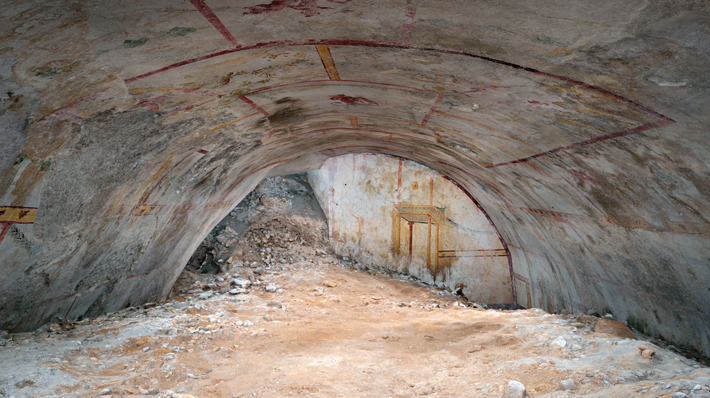 A small crack in a vaulted ceiling led archaeologists to a new room of the Domus Aurea, or “Golden House,” the immense pleasure palace built by the emperor Nero after a fire devastated Rome in A.D. 64. After Nero’s death, the Domus Aurea was seen as the emperor’s folly, and the structure’s interior was completely filled in. A public park for all Romans to enjoy was built on top. It was not until the fifteenth century that, quite by accident, the vast property was rediscovered. Since then, the Domus Aurea has been the site of exploration, excavation—and nearly constant restoration. During one such restoration project, archaeologists found the new room, which is covered in frescoes. “It was very emotional for us to find a previously unknown room, or maybe one that we had lost track of,” says archaeologist Alessandro d’Alessio of the Italian Ministry of Cultural Heritage. The frescoes depict a centaur and other mythological figures, a whistle-like instrument, decorative plants, and a column topped with a golden bowl and sphinx that has given the space its name, the “Room of the Sphinxes.”
A small crack in a vaulted ceiling led archaeologists to a new room of the Domus Aurea, or “Golden House,” the immense pleasure palace built by the emperor Nero after a fire devastated Rome in A.D. 64. After Nero’s death, the Domus Aurea was seen as the emperor’s folly, and the structure’s interior was completely filled in. A public park for all Romans to enjoy was built on top. It was not until the fifteenth century that, quite by accident, the vast property was rediscovered. Since then, the Domus Aurea has been the site of exploration, excavation—and nearly constant restoration. During one such restoration project, archaeologists found the new room, which is covered in frescoes. “It was very emotional for us to find a previously unknown room, or maybe one that we had lost track of,” says archaeologist Alessandro d’Alessio of the Italian Ministry of Cultural Heritage. The frescoes depict a centaur and other mythological figures, a whistle-like instrument, decorative plants, and a column topped with a golden bowl and sphinx that has given the space its name, the “Room of the Sphinxes.”
Peruvian Mass Sacrifice
By JARRETT A. LOBELL
Thursday, December 05, 2019
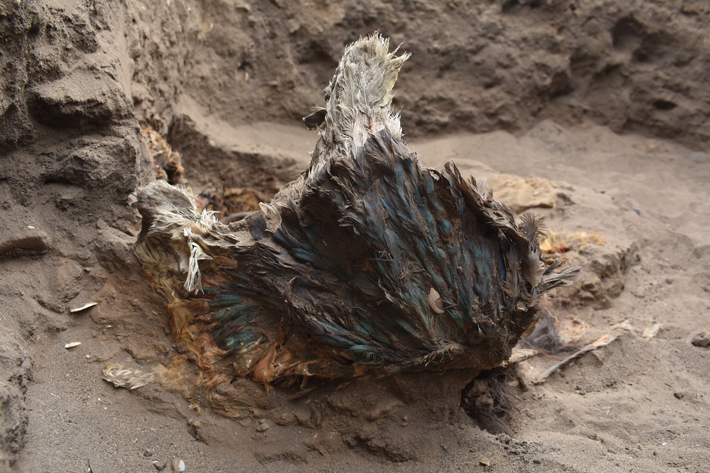
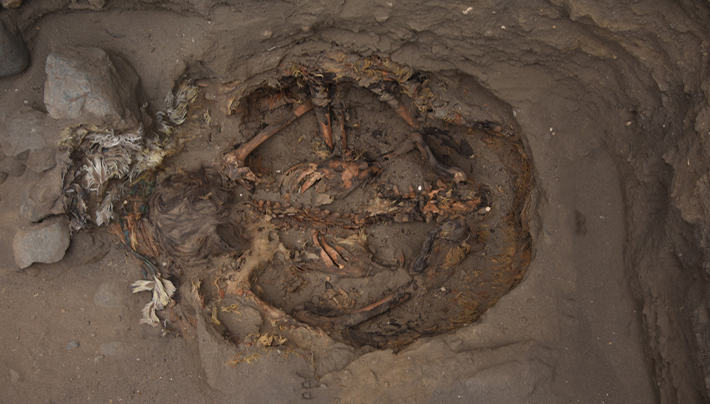 More than 230 children and nearly 400 llamas—along with evidence that suggests they were part of three distinct mass sacrificial events—have been discovered at the coastal site of Pampa la Cruz. The first of these events dates to around A.D. 1250, and is thus the earliest mass child and animal sacrifice in the region. Similar mass sacrifices have been found from later dates in the same area, and have been interpreted as offerings to the gods by the local Chimu people in response to the destruction wrought by El Niño events. But archaeologist Gabriel Prieto of the University of Florida believes the earliest Pampa la Cruz sacrifice may have had a political purpose. “It’s intriguing that this first sacrificial event occurred at exactly the time the Chimu were conquering people such as the Lambayeque, who lived in the valleys to the north,” says Prieto. “It’s fascinating to imagine that the victims may have been Lambayeque citizens brought here to celebrate those victories.”
More than 230 children and nearly 400 llamas—along with evidence that suggests they were part of three distinct mass sacrificial events—have been discovered at the coastal site of Pampa la Cruz. The first of these events dates to around A.D. 1250, and is thus the earliest mass child and animal sacrifice in the region. Similar mass sacrifices have been found from later dates in the same area, and have been interpreted as offerings to the gods by the local Chimu people in response to the destruction wrought by El Niño events. But archaeologist Gabriel Prieto of the University of Florida believes the earliest Pampa la Cruz sacrifice may have had a political purpose. “It’s intriguing that this first sacrificial event occurred at exactly the time the Chimu were conquering people such as the Lambayeque, who lived in the valleys to the north,” says Prieto. “It’s fascinating to imagine that the victims may have been Lambayeque citizens brought here to celebrate those victories.”
Another possible interpretation is that the sacrifice was meant to honor Taycanamo, the legendary founder of the Chimu, who is said to have come from the sea and walked south to found the Chimu capital of Chan Chan around A.D. 1000. Pampa la Cruz overlooks the exact spot where he is thought to have landed.
Tomb of the Silver Dragons
By ERIC A. POWELL
Thursday, December 05, 2019

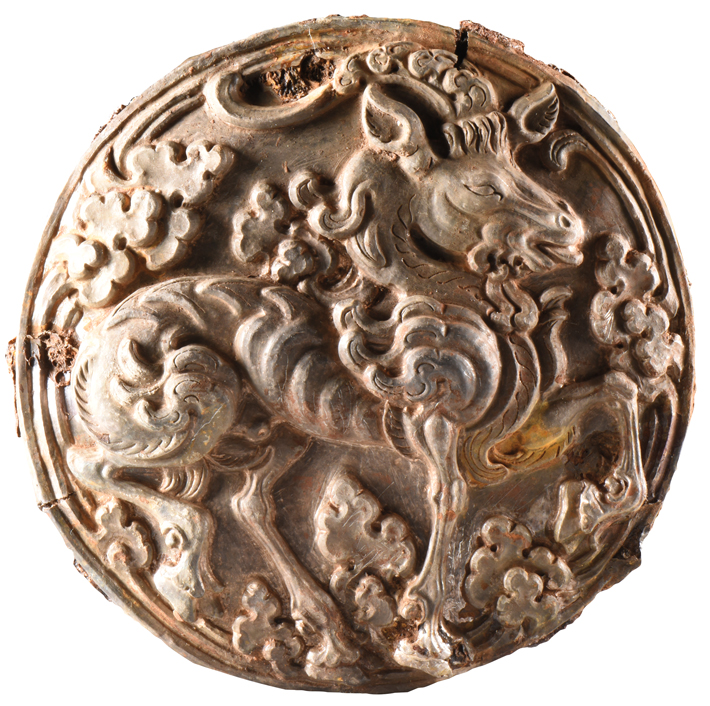 In north-central Mongolia, archaeologists have unearthed two lavish tombs built for nobles of the Xiongnu Empire. A nomadic people who dominated the eastern Eurasian steppes from the third century B.C. to the first century A.D., the Xiongnu frequently waged war against China’s Han Dynasty (206 B.C.– A.D. 220). To defend against these incursions, the Han built fortifications that eventually became part of the Great Wall. Both of the Xiongnu tombs, which were excavated by a team from Ulaanbaatar University and the Henan Provincial Institute of Cultural Heritage and Archaeology, contained sumptuous grave goods. In the larger tomb, researchers found wooden boxes that held silver rings, jade belt hooks, and a pair of gilded silver dragons that may once have served as handles on a vessel. The smaller tomb contained the remains of a man buried with a horse-drawn carriage, 15 horse heads, and 19 silver equestrian ornaments, each depicting a unicorn deity. The team also recovered part of a jade-decorated sword from this grave, the first to be found in a Xiongnu tomb.
In north-central Mongolia, archaeologists have unearthed two lavish tombs built for nobles of the Xiongnu Empire. A nomadic people who dominated the eastern Eurasian steppes from the third century B.C. to the first century A.D., the Xiongnu frequently waged war against China’s Han Dynasty (206 B.C.– A.D. 220). To defend against these incursions, the Han built fortifications that eventually became part of the Great Wall. Both of the Xiongnu tombs, which were excavated by a team from Ulaanbaatar University and the Henan Provincial Institute of Cultural Heritage and Archaeology, contained sumptuous grave goods. In the larger tomb, researchers found wooden boxes that held silver rings, jade belt hooks, and a pair of gilded silver dragons that may once have served as handles on a vessel. The smaller tomb contained the remains of a man buried with a horse-drawn carriage, 15 horse heads, and 19 silver equestrian ornaments, each depicting a unicorn deity. The team also recovered part of a jade-decorated sword from this grave, the first to be found in a Xiongnu tomb.
Denisovans at Altitude
By LYDIA PYNE
Thursday, December 05, 2019
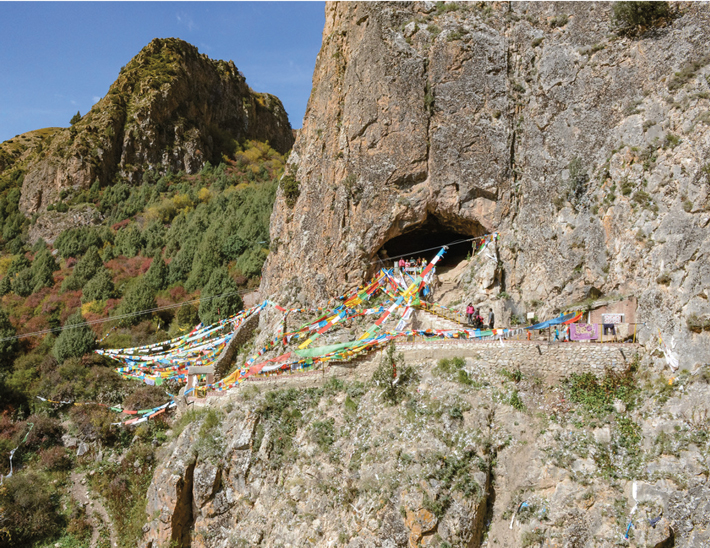 Some 40 years ago, a Buddhist monk uncovered a mandible in Baishiya Karst Cave, more than 10,000 feet above sea level on the Tibetan Plateau. The specimen has now been dated to 160,000 years ago, and analysis of proteins from its teeth indicates that it belonged to a member of the hominin species known as Denisovans. These elusive ancient humans were previously known only through fragmentary remains of several individuals, all of which were found in southern Siberia’s Denisova Cave, which is just 2,300 feet above sea level and almost 1,750 miles northwest of Baishiya Karst Cave. “This mandible reveals that Denisovans were geographically distributed much more widely and at higher altitude than we previously thought,” says archaeologist Dongju Zhang of Lanzhou University.
Some 40 years ago, a Buddhist monk uncovered a mandible in Baishiya Karst Cave, more than 10,000 feet above sea level on the Tibetan Plateau. The specimen has now been dated to 160,000 years ago, and analysis of proteins from its teeth indicates that it belonged to a member of the hominin species known as Denisovans. These elusive ancient humans were previously known only through fragmentary remains of several individuals, all of which were found in southern Siberia’s Denisova Cave, which is just 2,300 feet above sea level and almost 1,750 miles northwest of Baishiya Karst Cave. “This mandible reveals that Denisovans were geographically distributed much more widely and at higher altitude than we previously thought,” says archaeologist Dongju Zhang of Lanzhou University.
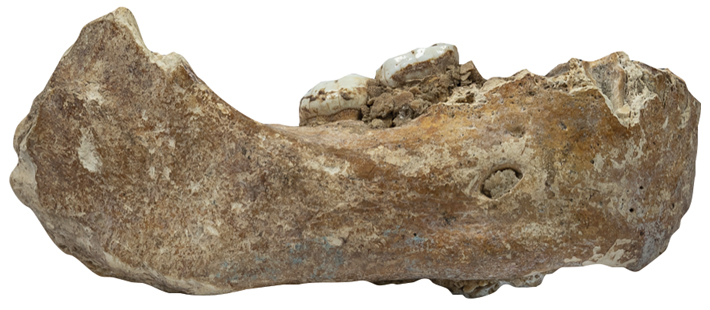 Earlier studies of Denisovan genetic material had detected a mutation that fosters survival in low-oxygen environments found in extremely high-altitude locations such as the Tibetan Plateau. This same mutation has been identified in present-day Tibetans, and the discovery that Denisovans once inhabited the region may explain how they obtained this life-preserving adaptation.
Earlier studies of Denisovan genetic material had detected a mutation that fosters survival in low-oxygen environments found in extremely high-altitude locations such as the Tibetan Plateau. This same mutation has been identified in present-day Tibetans, and the discovery that Denisovans once inhabited the region may explain how they obtained this life-preserving adaptation.
Norman Conquest Coin Hoard
By BENJAMIN LEONARD
Thursday, December 05, 2019
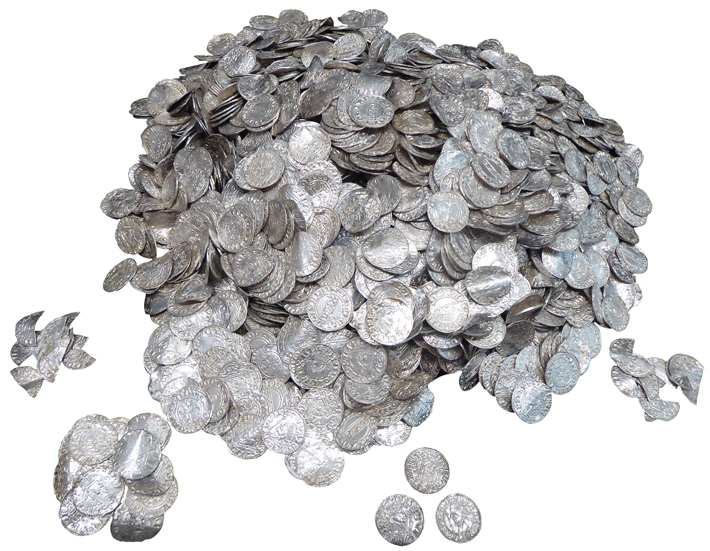 On October 14, 1066, William the Conqueror (r. 1066–1087) defeated the last Anglo-Saxon king of England, Harold Godwinson (r. 1066), at the Battle of Hastings, ushering in Norman rule. According to British Museum researchers, the discovery in southwest England’s Chew Valley of a cache of more than 2,500 silver pennies from the reigns of both kings underscores the political uncertainty of the years surrounding the Norman Conquest.
On October 14, 1066, William the Conqueror (r. 1066–1087) defeated the last Anglo-Saxon king of England, Harold Godwinson (r. 1066), at the Battle of Hastings, ushering in Norman rule. According to British Museum researchers, the discovery in southwest England’s Chew Valley of a cache of more than 2,500 silver pennies from the reigns of both kings underscores the political uncertainty of the years surrounding the Norman Conquest.
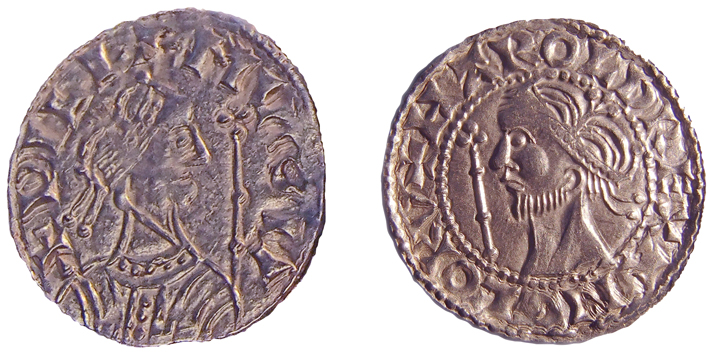 Most of the 1,236 coins in the hoard that feature Harold’s face were minted in southeast England, which indicates steadfast allegiance to him in the region despite the coming threat of William’s invasion. By contrast, all 1,310 coins featuring William were issued after his Christmas Day coronation, suggesting that by that point his claim to the throne was generally recognized. One coin minter seems to have taken advantage of the tumultuous period following Harold’s death. Two “mule” coins, struck with Harold’s visage on one side and William’s on the other, represent this sneaky minter’s attempt to avoid the expense of purchasing fresh dies to produce new coinage, as was required every few years. All together, the hoard’s coins—some cut into quarters or halves to make smaller denominations—would have been more than sufficient to purchase at least 500 sheep.
Most of the 1,236 coins in the hoard that feature Harold’s face were minted in southeast England, which indicates steadfast allegiance to him in the region despite the coming threat of William’s invasion. By contrast, all 1,310 coins featuring William were issued after his Christmas Day coronation, suggesting that by that point his claim to the throne was generally recognized. One coin minter seems to have taken advantage of the tumultuous period following Harold’s death. Two “mule” coins, struck with Harold’s visage on one side and William’s on the other, represent this sneaky minter’s attempt to avoid the expense of purchasing fresh dies to produce new coinage, as was required every few years. All together, the hoard’s coins—some cut into quarters or halves to make smaller denominations—would have been more than sufficient to purchase at least 500 sheep.
Advertisement
Advertisement
IN THIS ISSUE
Advertisement

Recent Issues
-
 May/June 2024
May/June 2024
-
 March/April 2024
March/April 2024
-
 January/February 2024
January/February 2024
-
 November/December 2023
November/December 2023
-
 September/October 2023
September/October 2023
-
 July/August 2023
July/August 2023
-
 May/June 2023
May/June 2023
-
 March/April 2023
March/April 2023
-
 January/February 2023
January/February 2023
-
 November/December 2022
November/December 2022
-
 September/October 2022
September/October 2022
-
 July/August 2022
July/August 2022
-
 May/June 2022
May/June 2022
-
 March/April 2022
March/April 2022
-
 January/February 2022
January/February 2022
-
 November/December 2021
November/December 2021
-
 September/October 2021
September/October 2021
-
 July/August 2021
July/August 2021
-
 May/June 2021
May/June 2021
-
 March/April 2021
March/April 2021
-
 January/February 2021
January/February 2021
-
 November/December 2020
November/December 2020
-
 September/October 2020
September/October 2020
-
 July/August 2020
July/August 2020
-
 May/June 2020
May/June 2020
-
 March/April 2020
March/April 2020
-
 January/February 2020
January/February 2020
-
 November/December 2019
November/December 2019
-
 September/October 2019
September/October 2019
-
 July/August 2019
July/August 2019
-
 May/June 2019
May/June 2019
-
 March/April 2019
March/April 2019
-
 January/February 2019
January/February 2019
-
 November/December 2018
November/December 2018
-
 September/October 2018
September/October 2018
-
 July/August 2018
July/August 2018
-
 May/June 2018
May/June 2018
-
 March/April 2018
March/April 2018
-
 January/February 2018
January/February 2018
-
 November/December 2017
November/December 2017
-
 September/October 2017
September/October 2017
-
 July/August 2017
July/August 2017
-
 May/June 2017
May/June 2017
-
 March/April 2017
March/April 2017
-
 January/February 2017
January/February 2017
-
 November/December 2016
November/December 2016
-
 September/October 2016
September/October 2016
-
 July/August 2016
July/August 2016
-
 May/June 2016
May/June 2016
-
 March/April 2016
March/April 2016
-
 January/February 2016
January/February 2016
-
 November/December 2015
November/December 2015
-
 September/October 2015
September/October 2015
-
 July/August 2015
July/August 2015
-
 May/June 2015
May/June 2015
-
 March/April 2015
March/April 2015
-
 January/February 2015
January/February 2015
-
 November/December 2014
November/December 2014
-
 September/October 2014
September/October 2014
-
 July/August 2014
July/August 2014
-
 May/June 2014
May/June 2014
-
 March/April 2014
March/April 2014
-
 January/February 2014
January/February 2014
-
 November/December 2013
November/December 2013
-
 September/October 2013
September/October 2013
-
 July/August 2013
July/August 2013
-
 May/June 2013
May/June 2013
-
 March/April 2013
March/April 2013
-
 January/February 2013
January/February 2013
-
 November/December 2012
November/December 2012
-
 September/October 2012
September/October 2012
-
 July/August 2012
July/August 2012
-
 May/June 2012
May/June 2012
-
 March/April 2012
March/April 2012
-
 January/February 2012
January/February 2012
-
 November/December 2011
November/December 2011
-
 September/October 2011
September/October 2011
-
 July/August 2011
July/August 2011
-
 May/June 2011
May/June 2011
-
 March/April 2011
March/April 2011
-
 January/February 2011
January/February 2011
Advertisement






